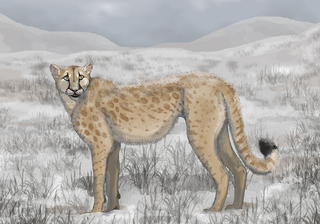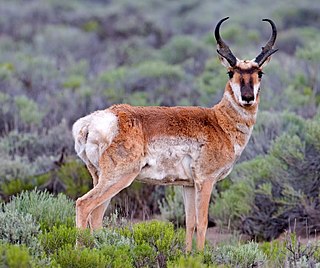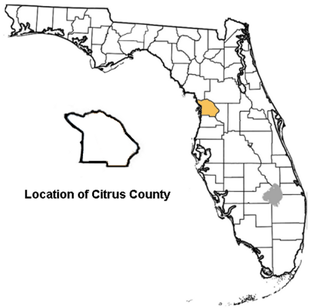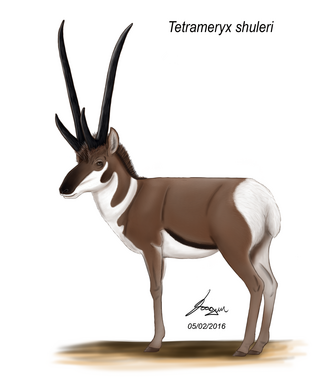
A pika is a small, mountain-dwelling mammal native to Asia and North America. With short limbs, a very round body, an even coat of fur, and no external tail, they resemble their close relative, the rabbit, but with short, rounded ears. The large-eared pika of the Himalayas and nearby mountains lives at elevations of more than 6,000 m (20,000 ft).

Miracinonyx is an extinct genus of felids belonging to the subfamily Felinae that was endemic to North America from the Pleistocene epoch and morphologically similar to the modern cheetah, although its apparent similar ecological niches have been considered questionable due to anatomical morphologies of the former that would have crippled any ability to run as fast. The genus was originally known from fragments of skeletons, but nearly complete skeletons have been recovered from Natural Trap Cave in northern Wyoming.

The Antilocapridae are a family of artiodactyls endemic to North America. Their closest extant relatives are the giraffids. Only one species, the pronghorn, is living today; all other members of the family are extinct. The living pronghorn is a small ruminant mammal resembling an antelope.

Hayoceros is an extinct genus of the artiodactyl family Antilocapridae, endemic to North America during the Pleistocene epoch, existing for about 1.5 million years.

Scapanus is a genus of moles in the family Talpidae. They live in North America from west of the Rockies south to Baja California del Norte, and north to British Columbia, wherever conditions permit a mole population; that is to say, apart from the most sandy, rocky, or developed places. As they are one genus, they are very closely related, but as species, they rarely if ever interbreed successfully.

Prolagus is an extinct genus of lagomorph. Over 20 species have been named, and the genus was abundant and widespread in Europe during the Neogene. However, by the end of the Middle Pleistocene, it was confined to a single species, the Sardinian pika, on the Corsica, Sardinia, and surrounding islands, where it survived into historical times. In North Africa and Western Asia, the genus is known from the Miocene and Pliocene. The scientific name may mean "before hares" or "primitive hares". Its taxonomy is disputed, with it either being considered a member of the family Ochotonidae, which includes living pikas, or the only member of the family Prolagidae.
Conkling Cavern is a paleontological and archaeological site located in Doña Ana County, New Mexico. It was excavated in the late 1920s under the direction of Chester Stock. Unfortunately, Stock never published the fossil fauna from the excavations. Instead, R. P. Conkling, who had drawn scientific attention to the site, published very preliminary lists of mammals identified by Stock and birds identified by Howard. Several authors have done research on portions of the recovered fossil fauna. Excavated before modern dating techniques were developed, little is known about the chronology except some apparently is Holocene and much is Pleistocene in age.

Bootherium is an extinct bovid genus from the middle to late Pleistocene of North America which contains a single species, Bootherium bombifrons. Vernacular names for Bootherium include Harlan's muskox, woodox, woodland muskox, helmeted muskox, or bonnet-headed muskox. Bootherium was one of the most widely distributed muskox species in North America during the Pleistocene era. It is most closely related to the modern muskox, from which it diverged around 3 million years ago, it is possibly synonymous with Euceratherium, although this is uncertain.

The latter half of the Late Pleistocene to the beginning of the Holocene saw extinctions of numerous predominantly megafaunal species, which resulted in a collapse in faunal density and diversity across the globe. The extinctions during the Late Pleistocene are differentiated from previous extinctions by the widespread absence of ecological succession to replace these extinct megafaunal species, and the regime shift of previously established faunal relationships and habitats as a consequence. The timing and severity of the extinctions varied by region and are thought to have been driven by varying combinations of human and climatic factors. Human impact on megafauna populations is thought to have been driven by hunting ("overkill") as well as possibly environmental alteration. The relative importance of human vs climatic factors in the extinctions has been the subject of long-running controversy.

The pronghorn is a species of artiodactyl mammal indigenous to interior western and central North America. Though not an antelope, it is known colloquially in North America as the American antelope, prong buck, pronghorn antelope and prairie antelope, because it closely resembles the antelopes of the Old World and fills a similar ecological niche due to parallel evolution. It is the only surviving member of the family Antilocapridae.

Ramoceros is an extinct genus of the artiodactyl family Antilocapridae endemic to Middle Miocene (Clarendonian) North America.

The Inglis quarry or Inglis quarry sites 1A and 1C are assemblages of vertebrate fossils dating from the Pleistocene ~1.8 Mya—300,000 years ago, located in the phosphate quarries near the town of Inglis, Citrus County, northern Florida.

Stockoceros is an extinct genus of the North American artiodactyl family Antilocapridae (pronghorns), known from what is now Mexico and the southwestern United States. The genus survived until about 12,000 years ago, and was present when Paleo-Indians reached North America.

A list of prehistoric and extinct species whose fossils have been found in the La Brea Tar Pits, located in present-day Hancock Park, a city park on the Miracle Mile section of the Mid-Wilshire district in Los Angeles, California.

Tetrameryx is an extinct genus of the North American artiodactyl family Antilocapridae, known from Mexico, the western United States, and Saskatchewan in Canada.

Merriamoceros is an extinct genus of pronghorn. It is known from a single species, which is also the type species, M. coronatus.

Capromeryx was a genus of dwarf pronghorns (Antilocapridae) that originated in North America during the Pliocene about 5 million years ago. The closest living relative and only surviving member of the family is the North American pronghorn.
Antilocapra pacifica, also known as the Pacific pronghorn, is an extinct antilocaprid from the Late Pleistocene of California.

Hydrochoerus hesperotiganites is an extinct species of capybara that lived in San Diego County, California, during the Rancholabrean stage of the Pleistocene. It is currently the only known capybara of the genus Hydrochoerus found in North America. It was closely related to the modern Greater and Lesser Capybara.

















